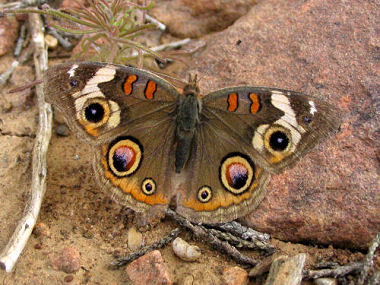The Common Buckeye Butterfly has a
wingspan of 2 - 2.5 inches
in width and is brown overall in color. The butterfly's forewing has 2
orange cell bars and 2 eyespots, the largest (and lower) of which is
contained in
 a
white band. The hindwing also has 2 eyespots; the upper one is
largest and contains a magenta crescent. The underside of the hindwing
is brown or tan in the wet season (summer) form and rose-red in the dry
season (fall) form. a
white band. The hindwing also has 2 eyespots; the upper one is
largest and contains a magenta crescent. The underside of the hindwing
is brown or tan in the wet season (summer) form and rose-red in the dry
season (fall) form.
|
It is thought that the eyespots
of the Common Buckeye Butterfly may be used to scare away
predators. |
The Common Buckeye Butterfly prefers open, sunny areas
with low vegetation and some bare ground. Males perch during the day to
watch for females, flying periodically to patrol or to chase other
flying insects. Females lay eggs singly on leaf buds or on the upperside
of host plant leaves upon which the caterpillar feeds (including plants
from the snapdragon, plantain and acanthus families). Adult butterflies
live for about 10 days. The Common Buckeye is found throughout the
southern United States and north along the coasts to central California
and North Carolina; as well as south to Bermuda, Cuba, and southern
Mexico. |

